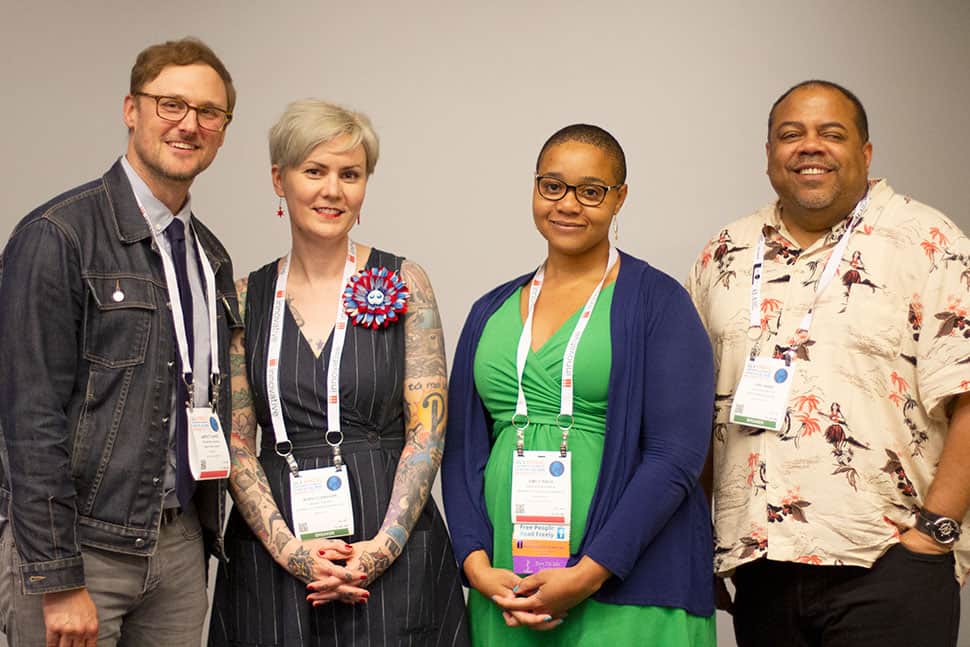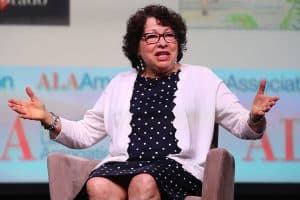
A new toolkit to help schools prepare for and protect their patrons from hate speech and incidents involving extremist groups was the subject of a panel in the News You Can Use series Saturday afternoon.
Confronting White Nationalism in Schools was published by the Western States Center in Portland, Oregon, and is available for free download.
The toolkit inspired Jarrett Dapier, young adult librarian at Skokie (Ill.) Public Library, to look at how libraries should respond to similar events. He said he was motivated by the rise of incidents involving “alt-right, white nationalist, and hate groups,” including a flash protest on April 27 during an author event at the Washington, D.C., bookstore Politics and Prose by a group calling itself the American Identity Movement. Dapier said libraries were also targeted by groups that are placing racist and anti-Semitic fliers inside books where patrons can find them.
Emily Knox, associate professor at the iSchool at University of Illinois at Urbana-Champaign and the new president of the ALA’s Freedom to Read Foundation, spoke in her portion of the panel about the concept of “law versus justice” and noted that, while libraries are bound by laws, “the law is rarely just.” She encouraged librarians to accept that “freedom of speech is a not a progressive but a liberal value,” but stated that she believes “justice will only ever be achieved through protecting freedom of speech.” When it comes to white nationalism in libraries, part of the solution is “more undermining speech,” not less.
Nora Flanagan, a Chicago public school teacher who coauthored the toolkit, said she included five scenarios (from the anonymous use of hate symbols to actual white nationalists organizing at the school) that actually occurred at the two schools where she taught English. Each scenario includes suggested approaches that students, staff, administration, parents, and community members can take in response. The most important guideline, Flanagan said, is to “find a place in the middle. Do not overreact to a situation,” as it can quickly backfire.
Eric Ward, executive director of the Western States Center, an organization that helps communities strengthen inclusive democracy, offered an important distinction between white supremacy and white nationalism. “White supremacy,” Ward said, “is a historical and present-day system of exploitation in which non-whites are considered racially inferior. The civil rights movement of the 1960s effectively dismantled white supremacy as a rule of law. White nationalism is a movement that arose in direct response to that failure. Its goal ultimately is the creation of an all-white ethnostate within the United States.”
Dapier added that the best defense is to anticipate what form white nationalist activity might take in your library and prepare for a proper legal response. “Do you have legal help on retainer?” he asked. “If not, the Office for Intellectual Freedom can assist you in getting legal advice.” Dapier also recommended examining how your library treats “problem patrons” and whether young black men are more frequently identified as such. “Skokie Public Library is reluctant to call the police except when a violent situation is taking place.”
Dapier also suggested examining your programs, collections, posters, and even your personnel to make sure that they represent diversity—even if your community is predominantly white. “On an unconscious level, you are saying that whiteness is all that matters,” he added, “and it gives the impression that you are reinforcing systems of repression that only a small minority of your patrons might support.”


